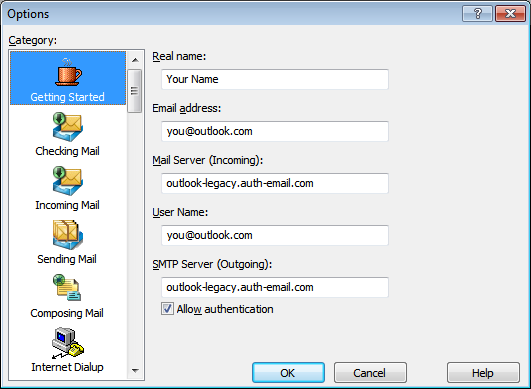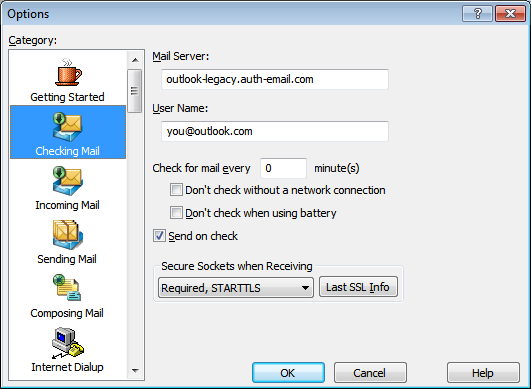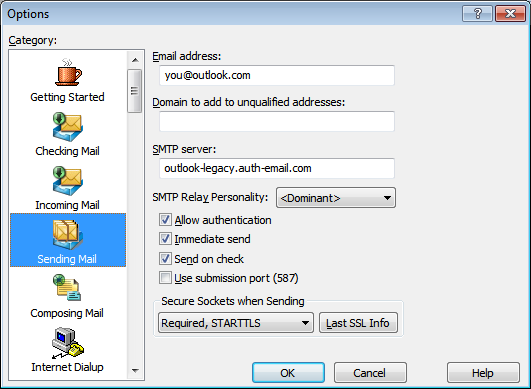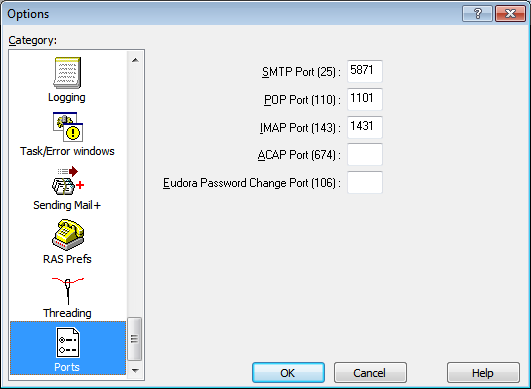Using Eudora with OAuth email providers
Yes, you can still use Eudora, the beloved classic email client, with modern email infrastructure — thanks to Auth-Email and a few patches.
This complete setup guide walks you through installing required updates and configuring your Eudora settings to work with Auth-Email's IMAP, POP and SMTP servers.
Step 1: Patch Eudora for modern SSL/TLS support
Eudora was built before modern encryption protocols, so you'll need to install a patch that enables SSL/TLS compatibility with newer mail servers.
If you've used Eudora in recent years, you have probably already made this update. But if you're setting up Eudora for the first time, or you're not sure if you have the patch, follow these steps. There's no harm in applying it again.
Download SSL/TLS patch files
Choose one of the following trusted sources:
Install instructions
- Close Eudora if it is open
- Double-click the downloaded zip file to view its contents
- Copy the entire contents of the zip file (
Ctrl+AthenCtrl+C) - Right click on your Eudora app icon, and choose “Open file location” (you may need to click “Properties” first)
- A window will open, showing the Eudora installation directory
- Paste the copied files here (
Ctrl+V), and confirm any prompts to replace existing files
By completing this step, you have replaced Eudora's original SSL handler with one that supports more recent SSL/TLS versions, encryption methods and certificates.
Step 2: Enable Eudora's hidden Ports options
Eudora's configuration interface hides some advanced settings by default. To access the Ports screen:
- Close Eudora if it is open
- Right click on your Eudora app icon, and choose “Open file location” (you may need to click “Properties” first)
- Open the
extrastuffdirectory, and locate theesoteric.xpifile - Copy this file (
Ctrl+C) - Go back one level to the main Eudora directory
- Paste the
esoteric.xpifile here (Ctrl+V)
Eudora's options pages will now display a Ports configuration screen as the last item.
Step 3: Enable legacy SSL/TLS in Auth-Email
Because Eudora doesn't support modern SSL/TLS fully, even with the patches we applied in Step 1, you need to enable legacy SSL/TLS mode in your Auth-Email account settings.
- Log into your Auth-Email dashboard
- Locate the account you want to use with Eudora, and expand the account configuration details
- At the bottom, locate the “Enable legacy SSL/TLS” toggle, and make sure it is enabled
- Your changes are saved automatically
This allows Eudora to connect to Auth-Email using opportunistic SSL/TLS (STARTTLS) using protocols and ciphers that it understands.
Step 4: Configure Eudora (Tools > Options)
There are four key screens in Eudora's Tools > Options menu to configure for use with Auth-Email. Enter the following details in each screen. Make sure you use the correct server names and ports as shown in the Auth-Email dashboard for your account. Show configurations for an account provided by Outlook:
1. Getting Started
- Real Name: Your name
- Email Address: Your full email address (e.g.,
[email protected]) - Mail Server (Incoming):
outlook-legacy.auth-email.com - User Name: Your full email address (e.g.,
[email protected]) - SMTP Server (Outgoing):
outlook-legacy.auth-email.com - Allow authentication: ✅ (checked)
Here's an example of what the Getting Started options screen looks like in Eudora when using Outlook:

2. Checking Mail
Several of the options in this screen can be configured to your preference, but the following settings are essential. These same settings apply whether you use POP or IMAP. Show configurations for an account provided by Outlook:
- Mail Server:
outlook-legacy.auth-email.com - User Name: Your full email address (e.g.,
[email protected]) - Secure Sockets when Receiving:
Required, STARTTLS
Here's an example of what the Checking Mail options screen looks like in Eudora when using Outlook:

3. Sending Mail
Several of the options in this screen can be configured to your preference, but the following settings are essential. Show configurations for an account provided by Outlook:
- Email address: Your full email address (e.g.,
[email protected]) - SMTP Server:
outlook-legacy.auth-email.com - Allow authentication: ✅ (checked)
- Use submission port (587): ❌ (unchecked)
- Secure Sockets when Sending:
Required, STARTTLS
Here's an example of what the Sending Mail options screen looks like in Eudora when using Outlook:

4. Ports
Add the custom port settings in this screen for the protocols you intend to use. The other port settings should be left empty. Show configurations for an account provided by Outlook:
- SMTP Port (25):
5871 - POP Port (110):
1101 - IMAP Port (143):
1431
Here's an example of what the Ports options screen looks like in Eudora when using Outlook:

You're ready to go!
Once you've completed these steps:
- Test checking and sending mail from Eudora
- When you're prompted for a password, enter the one you set during account authorization in the Auth-Email dashboard
- Don't use your actual email account password here
- If you've forgotten the password you chose, you can reset it in the Auth-Email dashboard by re-authorizing the account
- If you see certificate warnings, ensure HermSSL is correctly installed and you're using the correct Auth-Email server names
- If login fails, double-check your Auth-Email account credentials and legacy SSL/TLS toggle
Troubleshooting tips
| Problem | Solution |
|---|---|
| Can't connect to server | Ensure “legacy SSL/TLS” is enabled in the Auth-Email dashboard |
| Certificate warning | Make sure you have followed Step 1 of this guide to update Eudora's SSL/TLS files |
| Ports tab missing | Refer to Step 2 of this guide, move esoteric.xpi to the correct folder, and restart Eudora |
| Mail appears twice in “Out” | Enable the “Skip sent message uploads” add-in in Auth-Email |
Related articles
- Connecting using a legacy email client or device
- Creating a “send as” address in Gmail
- Setting up multifunction printers and scan to email
- Using account add-ins to modify mail server behavior
🙋 Need more help?
If you run into any issues, please reach out to us at [email protected] — we'll help you get things working.